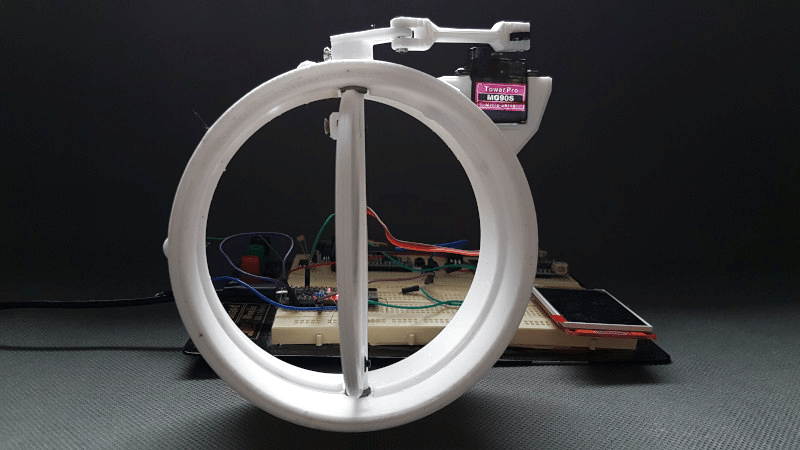It’s not something we always think about, but there’s plenty of hazardous fumes in the average workshop that can be deleterious to human health. Whether its soldering, lasercutting, or 3D printing, all of these processes release nasty chemicals into the air that are best filtered for health reasons. To help build out a working filtration system, [Fab] needed some valves, so set about printing some of his own.
[Fab] went with a simple butterfly valve design, similar to the throttle valve in most gasoline-powered cars. The butterfly vane rotates to vary the flow, turned by a small SG90 servo. A Wemos D1 Mini is used to run a pair of the valves, which are paired with a Y-adapter to connect both a soldering station and 3D printer to the fume extraction system. As a nice touch, a WiFi-enabled outlet is hooked up to the soldering iron which notifies the D1 Mini when it’s switched on, flipping the valve open to automatically start fume extraction.
It’s a tidy system that will enable [Fab] to breath easy in the workshop for years to come. Files are available for those wishing to print a set of butterfly valves for themselves. We’ve seen some other smart fume extractors before, too. Video after the break.















This is great! I’d love to build for my workshop. Would something like this work at a larger scale for HVAC vent automation?
You know these are already available to buy right? 100$ on grainger. Can automate them also. Oh and the ones you can buy are galvanized steel and don’t melt or corrode
This. Either an automated blast gate for dust collection systems, or an automated HVAC duct damper.
Or you can get a blast gate that works as a switch – the dust collector or fume extractor won’t turn on unless you open the gate. Which, while not automated-coolness, does require an affirmative action on your safety checklist rather passively hoping it works and you don’t die from the fumes.
Bob, for a student project or maker space, this would cost about $25 and the satisfaction of making something like this is awesome. Yes you can get galvanized, but sometimes it is all about just because I can.
Don’t understand the purpose.
It’s a valve for hazardous fume extraction from processes like resin 3D printing and soldering. Generally this valve will be paired with some kind of air duct and a fan. When you want to extract fumes it opens and the fan pushes those fumes out and away from where people might breathe them. When you aren’t using it, it closes so it isn’t open unnessacarily to prevent things like pest ingress or loss of temperature controlled air.
Could also be useful in a woodshop setting, to automate opening/closing of blast gates for dust extraction in response to individual tools turning on.
Or, if you’ve only got so much suck, don’t want to run a 3kW motor 24/7, for extraction at half a dozen machines, you connect them all to the same plenum and have the valves closed on the ones not operating and the valve open on the one you are using.
I doubt the servo would withstand the suction forces of a dust collector
Well that’s why it’s pivoted in the middle, you’ve got as much pressure pushing one side as pulling the other, in theory cancelling.
Had a main plenum with a dozen branches (been 30 years, so…) with simple slide valves in high school shop class. Automatic is more “cool” and might get better use by students or employees. Loosing suck and having to close valves was daily, but a generally good system.
Bob at I Like To Make Stuff did this with his blast gates in one of his earlier videos.
There’s more info here:
https://nerdiy.de/en/howto-3d-druck-ein-servogesteuertes-125mm-schmetterlingsventil-bauen/
Hey it’s butterfly in German too. Schmetterlingsventil might have to go on my favorite German words list.
It´s a flammable valve to evacuate fumes. It has the advantage it can melt or burn, disappearing itself into a dramatic meltdown disaster.
Always fun to automate something with motors and nice job. Back when I was installing my K40 laser cutter I had to put a new hole/vent in the roof for my exhaust. I mounted the big hydroponics fan to the underside of the garage roof near where I was putting the vent/hole. After cutting the hole, installing flashing and inserting the capped pipe from the outside, I noticed in the afternoon how much cooler my garage was compared to before I’d installed the now, open vent pipe.
It made me realize I needed not only a way to vent my laser cutter fumes but also a way to vent the garage of accumulated heat. With the project on hold until I figured out the solution I decided not to go with electro-mechanical actuators on a large 6″ Tee but instead to let gravity and air pressure take care of closing and opening the valve. The Tee insert which contains the gravity activated flapper valve was made in OpenSCAD and posted to Thingiverse:
https://www.thingiverse.com/thing:2867992
So just pressing the fan switch on/off button needs to be made more complicated ?
not what I meant… stuff always and eventually breaks down. if I hadn’t thought of a no-electronics/no-mechanical joints version I would have done something very similar and had another controller, wires, motors, etc bolted to the system and would deal with maintaining it.
i may use the design in my HVAC system since I do have to ducts needing regulation…